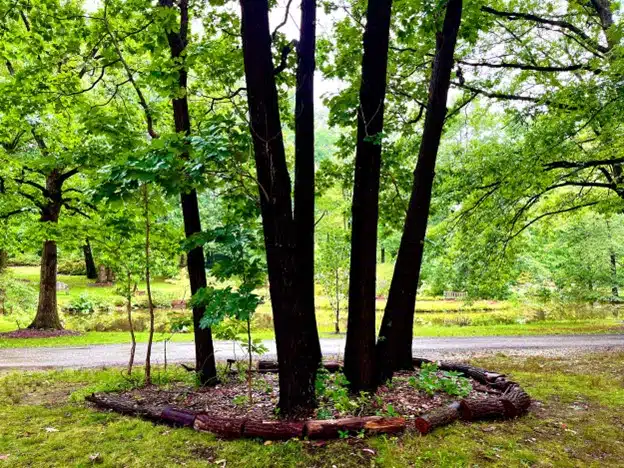
As the Collections team breaks down fallen limbs obstructing pathways and fells dead trees when necessary, you will see some of the resulting logs lining planting beds in the Layer Rhododendron Garden. This is not merely an aesthetic choice. While logs may be viewed as lifeless, a nuisance, or useful only as firewood, they play an indispensable role in the health of forest ecosystems. Logs provide essential habitat for diverse wildlife species. From nesting and shelter to storage and forage, logs offer vital services to cavity-dependent birds, reptiles, amphibians, and invertebrates alike. Through various stages of decomposition, logs support an increasing number of decomposers and their predators while slowly returning nutrients to the soil below.

Drumming for Dinner (and dates)
Showy birds are some of the most charismatic log users. Pileated woodpeckers rhythmically peck and probe decaying logs in search of beetle larvae, termites, and carpenter ants—their preferred snack. Extensive woodpecker excavations open log buffets to other insectivores less suited to penetrating hardwoods like wrens and nuthatches. Ruffed grouse, though not insect foragers, performatively perch atop “drumming logs” to stage territorial and mating displays.
Providing for Pollinators
While many of the state’s approximately 500 species of native bees are ground nesters, dozens rely on dead wood to complete their life cycles. Leafcutter bees, orchard bees, masked bees, and mason bees repurpose holes left by boring beetle larvae as ideal nesting sites. Select sweat bees and digger bees excavate their own nesting cavities in soft rotting wood. Some of these, of course, are likely to become woodpecker food. Those that survive emerge to do critical work pollinating Ohio’s native flora as well as agricultural crops.
Sheltering Salamanders (and herptiles galore)
Logs maintain moist microhabitats as they decompose, providing a cool and damp environment essential for specialized organisms. Among the more secretive log inhabitants, the majority of Ohio’s 24 salamander species hide and rest in and under rotting logs all day and hunt beneath those logs at night. Wood frogs too may be found beneath logs while loose bark provides convenient hiding places and homes for the likes of northern spring peepers. Five-lined skinks nest in rotting logs and often hibernate beneath them through winter.

Logs in the Landscape
Incorporating logs into your landscape is a simple, no-cost action with the potential for significant environmental impact. When a tree is toppled by a storm or large branches break off in the wind, consider alternatives to hauling the wood away. Logs can be thoughtfully placed bordering garden beds or discreetly nestled beneath shrubs and amidst mixed plantings. On slopes, strategic placement of logs on contour can mitigate erosion and aid establishment of new plantings while continuing to provide for wildlife. In urban and suburban landscapes, logs provide connectivity between habitat fragments by offering places to rest, to hide, and to refuel as animals move through disturbed environments. The birds, bees, and herptiles mentioned here are a small sampling of the life that lives on “dead” wood.

Kate Small
Gardener













